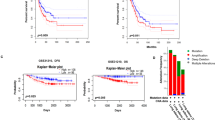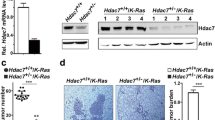Abstract
Objective
The expression levels of histone deacetylase 2 (HDAC2), eukaryotic initiation factor 5 (eIF5), and eukaryotic initiation factor 6 (eIF6), and relationship between HDAC2 and eIF5 or eIF6 in lung cancer tissues were investigated, in order to charify the relationship between HDAC2 and the prognosis of lung cancer patients and its influence on the expression of eIF5 and eIF6.
Methods
The expression of HDAC2, eIF5, and eIF6 in lung cancer tissues was detected by quantitative reverse transcription polymerase chain reaction. The expression correlation between HDAC2 and eIF5 or eIF6 was tested using a t test. The correlation between HDAC2 and eIF5 or eIF6 was analyzed using the TCGA database. The identified cells were constructed with small interfering siRNA and HDAC2 overexpression plasmid. The proliferation and migration ability of the identified cells was investigated by CCK8 and Transwell assays, respectively.
Results
HDAC2, eIF5, and eIF6 were overexpressed in lung cancer tissues, and HDAC2 expression level was negatively correlated with the prognosis of lung cancer patients. HDAC2 expression level was positively correlated with eIF5 and eIF6 expression levels. HDAC2 could regulate the expression of eIF5 and eIF6. The regulation of proliferation and invasion of lung cancer cells by HDAC2 depended on eIF5 and eIF6.
Conclusion
HDAC2, eIF5, and eIF6 were closely related with lung cancer tumorigenesis, which might be potential biological markers and therapeutic targets for lung cancer.
Similar content being viewed by others
References
Torre LA, Bray F, Siegel RL, et al. Global cancer statistics, 2012. CA Cancer J Clin, 2015,65(2):87–108
Chheang S, Brown K. Lung cancer staging: clinical and radiologic perspectives. Semin Intervent Radiol, 2013, 30(2):99–113
Cancer Genome Atlas Research N. Author Correction: Comprehensive molecular profiling of lung adenocarcinoma. Nature, 2018,559(7715):E12
Lee YM, Kim SJ, Lee JH, et al. Inhaled corticosteroids in COPD and the risk of lung cancer. Int J Cancer, 2018, 143(9):2311–2318
Lagerwaard FJ, Haasbeek CJ, Smit EF, et al. Outcomes of risk-adapted fractionated stereotactic radiotherapy for stage I non-small-cell lung cancer. Int J Radiat Oncol Biol Phys, 2008,70(3):685–692
Yang XJ, Seto E. The Rpd3/Hda1 family of lysine deacetylases: from bacteria and yeast to mice and men. Nat Rev Mol Cell Biol, 2008,9(3):206–218
Kelly RD, Cowley SM. The physiological roles of histone deacetylase (HDAC) 1 and 2: complex co-stars with multiple leading parts. Biochem Soc Trans, 2013, 41(3):741–749
Li L, Mei DT, Zeng Y. HDAC2 promotes the migration and invasion of non-small cell lung cancer cells via upregulation of fibronectin. Biomed Pharmacother, 2016,84:284–290
Conte MR, Kelly G, Babon J, et al. Structure of the eukaryotic initiation factor (eIF) 5 reveals a fold common to several translation factors. Biochemistry, 2006,45(14):4550–4558
Lopez Ribera I, Ruiz-Avila L, Puigdomenech P. The eukaryotic translation initiation factor 5, eIF-5, a protein from Zea mays, containing a zinc-finger structure, binds nucleic acids in a zinc-dependent manner. Biochem Biophys Res Commun, 1997,236(2):510–516
Lin J, Yu X, Xie L, et al. eIF6 Promotes Colorectal Cancer Proliferation and Invasion by Regulating AKT-Related Signaling Pathways. J Biomed Nanotechnol, 2019,15(7):1556–1567
Fritzsche FR, Weichert W, Roske A, et al. Class I histone deacetylases 1, 2 and 3 are highly expressed in renal cell cancer. BMC Cancer, 2008,8:381
Noh JH, Bae HJ, Eun JW, et al. HDAC2 provides a critical support to malignant progression of hepatocellular carcinoma through feedback control of mTORC1 and AKT. Cancer Res, 2014,74(6):1728–1738
Huang BH, Laban M, Leung CH, et al. Inhibition of histone deacetylase 2 increases apoptosis and p21Cip1/WAF1 expression, independent of histone deacetylase 1. Cell Death Differ, 2005,12(4):395–404
Gemoll T, Roblick UJ, Szymczak S, et al. HDAC2 and TXNL1 distinguish aneuploid from diploid colorectal cancers. Cell Mol Life Sci, 2011,68(19):3261–3274
Caraglia M, Park MH, Wolff EC, et al. eIF5A isoforms and cancer: two brothers for two functions? Amino Acids, 2013,44(1):103–109
Mathews MB, Hershey JW. The translation factor eIF5A and human cancer. Biochim Biophys Acta, 2015,1849(7):836–844
Ruggero D. Translational control in cancer etiology. Cold Spring Harb Perspect Biol, 2013,5(2):a12336
Sanvito F, Vivoli F, Gambini S, et al. Expression of a highly conserved protein, p27BBP, during the progression of human colorectal cancer. Cancer Res, 2000,60(3):510–516
Author information
Authors and Affiliations
Corresponding author
Ethics declarations
The authors have no conflict of interest.
Additional information
The study was supported by the Startup Fund for scientific research, Fujian Medical University (No. 2018QH1114), and Fujian Health and Healthy Middle-aged and Young Backbone Talents Training Project (No. 2019-ZQN-4).
Rights and permissions
About this article
Cite this article
Cai, Sx., Chen, Ws., Zeng, W. et al. Roles of HDAC2, eIF5, and eIF6 in Lung Cancer Tumorigenesis. CURR MED SCI 41, 764–769 (2021). https://doi.org/10.1007/s11596-021-2389-z
Received:
Accepted:
Published:
Issue Date:
DOI: https://doi.org/10.1007/s11596-021-2389-z




